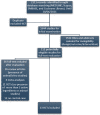Dietary Supplements for Female Infertility: A Critical Review of Their Composition
- PMID: 34684554
- PMCID: PMC8541636
- DOI: 10.3390/nu13103552
Dietary Supplements for Female Infertility: A Critical Review of Their Composition
Abstract
Infertility is the condition of about 15% of couples that cannot get a conception after one year of unprotected sexual intercourse. In females, the reduced reproductive capacity underlies the most varied causes. Dietary supplements (DS) might be used to improve the pregnancy rate and a wide range of DS are proposed today to support female fertility. Although many authors demonstrated the positive effect of some of these products, the real efficacy of this approach is still debated. In order to evaluate the potential efficacy of DS for female infertility, we analysed the products marketed in Italy, using an original approach. A review of literature was performed to evaluate the effect of nutraceuticals on various female reproductive outcomes and to detect the minimal effective daily dose (mED) able to improve at least one of these. Thereafter, we conceived a formula to classify the expected efficacy of each DS. Each DS was scored and included into three classes of expected efficacy: higher, lower, and none. Ten out of 24 supplements (41.7%) resulted in the higher and 8 (34.3%) in the lower efficacy group, the remaining 6 DS (25.0%) were expected to have no efficacy. DS marketed in Italy are usually blends of many substances that are frequently employed at a negligible dose or without any evidence of efficacy. These findings raise serious doubt about the potential effectiveness of most commercial DS for female infertility.
Keywords: assisted reproduction techniques; dietary supplements; female reproduction; fertility; oocyte quality; pregnancy rates; spontaneous ovulation.
Conflict of interest statement
All authors declare no competing interests.
Figures
Similar articles
-
Systematic Review and Critical Analysis on Dietary Supplements for Male Infertility: From a Blend of Ingredients to a Rationale Strategy.Front Endocrinol (Lausanne). 2022 Feb 4;12:824078. doi: 10.3389/fendo.2021.824078. eCollection 2021. Front Endocrinol (Lausanne). 2022. PMID: 35185789 Free PMC article.
-
Dietary Supplements for Male Infertility: A Critical Evaluation of Their Composition.Nutrients. 2020 May 19;12(5):1472. doi: 10.3390/nu12051472. Nutrients. 2020. PMID: 32438678 Free PMC article.
-
Food and drug supplements to improve fertility outcomes.Semin Reprod Med. 2014 Jul;32(4):245-52. doi: 10.1055/s-0034-1375176. Epub 2014 Jun 11. Semin Reprod Med. 2014. PMID: 24919023 Review.
-
In vitro fertilization and multiple pregnancies: an evidence-based analysis.Ont Health Technol Assess Ser. 2006;6(18):1-63. Epub 2006 Oct 1. Ont Health Technol Assess Ser. 2006. PMID: 23074488 Free PMC article.
-
The impact of surgical therapies for inflammatory bowel disease on female fertility.Cochrane Database Syst Rev. 2019 Jul 23;7(7):CD012711. doi: 10.1002/14651858.CD012711.pub2. Cochrane Database Syst Rev. 2019. PMID: 31334846 Free PMC article.
Cited by
-
Urtica pilulifera L. seed extract promotes folliculogenesis and alleviates the diminished ovarian reserve in the Balb/c mice model: An experimental study.Int J Reprod Biomed. 2024 Mar 25;22(2):111-126. doi: 10.18502/ijrm.v22i2.15708. eCollection 2024 Feb. Int J Reprod Biomed. 2024. PMID: 38628780 Free PMC article.
-
Association between micronutrient supplementation during pregnancy and preterm birth: evidence from a large-scale children survey and Mendelian randomization study.Front Public Health. 2025 May 9;13:1451006. doi: 10.3389/fpubh.2025.1451006. eCollection 2025. Front Public Health. 2025. PMID: 40416681 Free PMC article.
-
Psychological distress among women undergoing in vitro fertilization-embryo transfer: A cross-sectional and longitudinal network analysis.Front Psychol. 2023 Jan 5;13:1095365. doi: 10.3389/fpsyg.2022.1095365. eCollection 2022. Front Psychol. 2023. PMID: 36687877 Free PMC article.
-
Non-targeted metabolomic analysis of follicular fluid in infertile individuals with poor ovarian response.Front Endocrinol (Lausanne). 2025 May 12;16:1547550. doi: 10.3389/fendo.2025.1547550. eCollection 2025. Front Endocrinol (Lausanne). 2025. PMID: 40421242 Free PMC article.
-
The Importance of Natural Antioxidants in Female Reproduction.Antioxidants (Basel). 2023 Apr 11;12(4):907. doi: 10.3390/antiox12040907. Antioxidants (Basel). 2023. PMID: 37107282 Free PMC article. Review.
References
-
- Population Division, Department of Economic Social Affairs, United Nations . World Fertility Patterns 2015—Data Booklet (ST/ESA/SER.A/370) United Nations; San Francisco, CA, USA: 2015. [(accessed on 13 August 2021)]. Available online: https://www.un.org/en/development/desa/population/publications/pdf/ferti....
-
- Zegers-Hochschild F., Adamson G.D., de Mouzon J., Ishihara O., Mansour R., Nygren K. International Committee for Monitoring Assisted Reproductive Technology (ICMART) and the World Health Organization (WHO) revised glossary of ART terminology, 2009. Fertil. Steril. 2009;92:1520–1524. doi: 10.1016/j.fertnstert.2009.09.009. - DOI - PubMed
Publication types
MeSH terms
LinkOut - more resources
Full Text Sources
Medical



